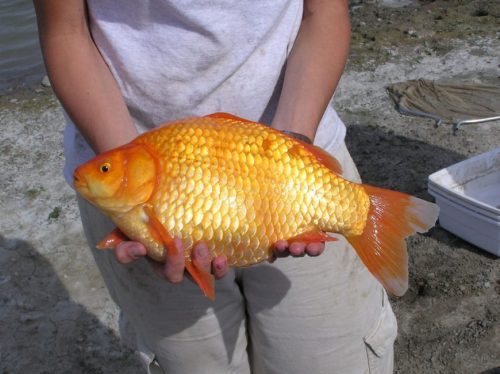You may have noticed that goldfish and koi have been springing up in ponds within the Don River Watershed and near the mouth of the Don. While these fish may seem like colourful additions to our local waterways, these aquatic species are not native to Ontario — and that could mean serious consequences for local species, habitats and ecosystems.
Goldfish and koi are actually domesticated versions of wild carp, bred selectively for their bright colours and intended for aquariums and backyard ponds. These fish are found in our local waterways either because they have escaped from outdoor ponds (during flooding events, for example) or, more commonly, because people have released them as unwanted pets.
What Harm Can a Small Fish Do?
Although koi and goldfish are not native species, they are easily able to thrive and multiply in our waters, which makes managing their populations difficult to control.
Both goldfish and koi feed by uprooting aquatic plants, which destroys the habitat for other fish and wildlife. Invasive species also compete for resources with native species and other wildlife, creating an imbalance in our natural ecosystem.
While we’re used to seeing small goldfish in aquariums and ponds, a goldfish released into the wild, with access to more food and a larger habitat, can grow to a substantial size.

Goldfish and koi also carry koi herpesvirus (KHV), an invasive fish virus that is linked to large fish die-offs and has now been detected in south-central Ontario.
Another Invader: Red-eared Slider Turtles
Like koi and goldfish, pet turtles (specifically red-eared sliders) make their way from pet stores into people’s homes and, when they’re no longer wanted, are often released into the wild. As a result, they are now the most common non-native turtle species found in Ontario.
Sliders can be recognized by the red stripe around their ears. While they start off small, they can grow to a maximum of 25 to 33 centimetres — something many people don’t realize when adopting them as pets.

Red-eared sliders are a threat to native species because they compete for food and basking sites. Invasive reptiles and amphibians can also carry diseases that may threaten native populations of animals, plants and even humans.
One of TRCA’s responsibilities is to monitor aquatic and terrestrial species, including the presence of invasive species, in order to assess the health of our regional watersheds and the Lake Ontario waterfront.
In Ontario, it’s illegal to release non-native species into our local ecosystems because of the threat they can pose to our local waters, wetlands and woodlands.
Nature has a way of balancing populations with controls and natural predators. By working together, we can help ensure that invasive species don’t interfere with the unique balance of our local ecosystems.

